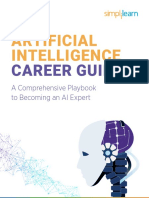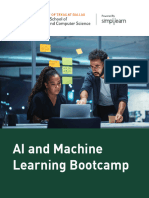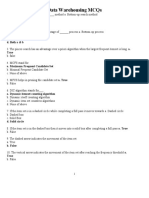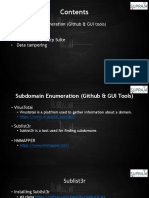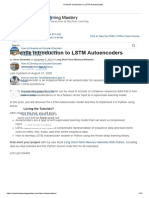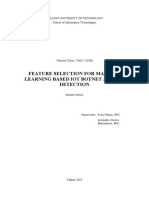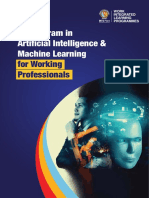ARTIFICIAL INTELLIGENCE
MASTER’S PROGRAM
In collaboration with IBM
www.simplilearn.com
1 | www.simplilearn.com
�Contents
About the Course 03
Key Features of Artificial Intelligence Engineer 04
Master’s Program
About IBM and Simplilearn collaboration 05
Learning Path Visualization 06
Program Outcomes 07
Who Should Enroll 09
Courses
Step 1: Introduction to Artificial Intelligence 10
Step 2: Statistics Essential 11
Step 3: Python for Data Science 13
Step 4: Data Science with Python 14
Step 5: Machine Learning 16
Step 6: Deep Learning with TensorFlow 18
Step 7: Advanced Deep Learning and Computer Vision 19
Step 8: Natural Language Processing 20
Step 9: AI Capstone Project 21
Electives 22
Certificates 23
Classroom-Level Immersion: Delivered Digitally 24
Customer Reviews 25
Corporate training 26
2 | www.simplilearn.com
�About the Course
This Artificial Intelligence Master’s excel in an AI career with exclusive
Program covers the crucial skills training and certification from
you need for a successful career in IBM. You will learn how to design
artificial intelligence (AI). As you intelligent models and advanced
undertake your AI engineer training, artificial neural networks and
you’ll master the concepts of deep leverage predictive analytics to solve
learning, machine learning, natural real-time problems in this course, in
language processing (NLP), plus the collaboration with IBM.
programming languages needed to
3 | www.simplilearn.com
� Key
Features
Industry-recognized
Portfolio-worthy
certificates from
capstone demonstrating
IBM(for IBM courses)
mastered concepts
and Simplilearn
20+ In-demand 15+ Real-life projects
skills providing hands-on
industry training
192 hours of 19 hours of
instructor-led training self-paced learning
4 | www.simplilearn.com
�About IBM and Simplilearn
collaboration
This joint partnership between company, headquartered in Armonk,
Simplilearn and IBM introduces New York, offering a plethora of
students to an integrated, blended technology and consulting services.
learning experience, with the goal of IBM invests $6 billion in research
making them experts in AI and data and development annually and has
science. Students will be industry- achieved five Nobel Prizes, nine US
ready for AI and data science job National Medals of Technology, five
roles upon successfully completing US National Medals of Science, six
this course. IBM is a leading cognitive Turing Awards, and 10 Inductions in
solution and cloud platform the US Inventors Hall of Fame.
About Simplilearn
Simplilearn is the world’s #1 online at a fraction of the cost and time as
bootcamp provider that enables traditional approaches. Over one million
learners through rigorous and highly professionals and 2000 corporate training
specialized training. We focus on organizations have harnessed our award-
emerging technologies and processes winning programs to achieve their career
that are transforming the digital world, and business goals.
5 | www.simplilearn.com
�Learning Path - Artificial Intelligence
Electives
Industry Master Class
– Artificial Intelligence
Introduction to
Artificial Intelligence
(3 hours)
Statistics Python for
Essentials Data Science
(4 hours) (1.2 hours)
Machine Data Science
Learning with Python
(72 hours) (72 hours)
Deep Learning Advanced Deep Natural
with TensorFlow Learning and Language
(43 hours) Computer Vision Processing
(41 hours) (51 hours)
AI Capstone
Project
(56 hours)
6 | www.simplilearn.com
�Artificial Intelligence Engineer
Master’s Program Outcomes
Learn about the major applications Master the skills and tools used
of Artificial Intelligence across by the most innovative Artificial
various use cases across various Intelligence teams across the globe
fields like customer service, financial as you delve into specializations, and
services, healthcare, etc. gain experience solving real-world
challenges.
Implement classical Artificial
Intelligence techniques such as Design and build your own intelligent
search algorithms, neural networks, agents and apply them to create
and tracking. practical Artificial Intelligence
projects including games, Machine
Learning models, logic constraint
satisfaction problems, knowledge-
based systems, probabilistic models,
agent decision-making functions and
Gain the ability to apply Artificial
more.
Intelligence techniques for problem-
solving and explain the limitations
of current Artificial Intelligence
techniques.
7 | www.simplilearn.com
�Understand the concepts of Learn to deploy deep learning
TensorFlow, its main functions, models on Docker, Kubernetes, and
operations, and the execution in serverless environments (cloud)
pipeline.
Understand the fundamentals of
Understand and master the concepts Natural Language Processing using
and principles of Machine Learning, the most popular library; Python’s
including its mathematical and Natural Language Toolkit (NLTK).
heuristic aspects.
Master and comprehend advanced
topics such as convolutional neural
networks, recurrent neural networks,
training deep networks, and high-
level interfaces.
8 | www.simplilearn.com
�Who Should Enroll in this Program?
With the demand for Artificial Developers aspiring to be an
Intelligence in a broad range of ‘Artificial Intelligence Engineer’
industries such as banking and or Machine Learning engineers
finance, manufacturing, transport
and logistics, healthcare, home Analytics managers who are
maintenance, and customer leading a team of analysts
service, the Artificial Intelligence
course is well suited for a variety Information architects who
of profiles like: want to gain expertise
in Artificial Intelligence
algorithms
Graduates looking to build a
career in Artificial Intelligence
and Machine Learning
9 | www.simplilearn.com
� S
T
E
Introduction to Artificial Intelligence P
1
Simplilearn’s Introduction to Artificial Intelligence course is designed to 2
help learners decode the mystery of Artificial Intelligence and understand
its business applications. The course provides an overview of Artificial 3
Intelligence concepts and workflows, Machine Learning, Deep Learning,
and performance metrics. You’ll learn the difference between supervised,
4
unsupervised learning—be exposed to use cases, and see how clustering 5
and classification algorithms help identify Artificial Intelligence business
applications. 6
7
Key Learning Objectives 8
Meaning, purpose, scope, stages, applications, and effects of Artificial
Intelligence
9
Fundamental concepts of Machine Learning and Deep Learning
Difference between supervised, semi-supervised and unsupervised
learning
Machine Learning workflow and how to implement the steps
effectively
The role of performance metrics and how to identify their essential
methods
Course curriculum
Lesson 1 - Decoding Artificial Intelligence
Lesson 2 - Fundamentals of Machine Learning and Deep Learning
Lesson 3 - Machine Learning Workflow
Lesson 4 - Performance Metrics
10 | www.simplilearn.com
� S
T
E
Statistics Essential P
1
Statistics is the science of assigning a probability to an event based 2
on experiments. It is the application of quantitative principles to
the collection, analysis, and presentation of numerical data. Ace the 3
fundamentals of Data Science, statistics, and Machine Learning with this
course. It will enable you to define statistics and essential terms related to
4
it, explain measures of central tendency and dispersion, and comprehend 5
skewness, correlation, regression, distribution. You will be able to make
data-driven predictions through statistical inference. 6
7
Key Learning Objectives 8
Understand the fundamentals of statistics 9
Work with different types of data
How to plot different types of data
Calculate the measures of central tendency, asymmetry, and variability
Calculate correlation and covariance
Distinguish and work with different types of distribution
Estimate confidence intervals
Perform hypothesis testing
Make data-driven decisions
Understand the mechanics of regression analysis
Carry out regression analysis
Use and understand dummy variables
Understand the concepts needed for data science even with Python
and R!
11 | www.simplilearn.com
�Course curriculum
Lesson 1 - Introduction
Lesson 2 - Sample or population data?
Lesson 3 - The fundamentals of descriptive statistics
Lesson 4 - Measures of central tendency, asymmetry, and variability
Lesson 5 - Practical example: descriptive statistics
Lesson 6 - Distributions
Lesson 7 - Estimators and estimates
Lesson 8 - Confidence intervals: advanced topics
Lesson 9 - Practical example: inferential statistics
Lesson 10 - Hypothesis testing: Introduction
Lesson 11 - Hypothesis testing: Let’s start testing!
Lesson 12 - Practical example: hypothesis testing
Lesson 13 - The fundamentals of regression analysis
Lesson 14 - Subtleties of regression analysis
Lesson 15 - Assumptions for linear regression analysis
Lesson 16 - Dealing with categorical data
Lesson 17 - Practical example: regression analysis
12 | www.simplilearn.com
� S
T
E
Python for Data Science P
1
Kickstart your learning of Python for Data Science with this introductory 2
course and familiarize yourself with programming. Carefully crafted by
IBM, upon completion of this course you will be able to write your Python 3
scripts, perform fundamental hands-on data analysis using the Jupyter-
based lab environment, and create your own Data Science projects using
4
IBM Watson. 5
6
Key Learning Objectives
7
Write your first Python program by implementing concepts of
variables, strings, functions, loops, conditions 8
Understand the nuances of lists, sets, dictionaries, conditions and 9
branching, objects and classes
Work with data in Python such as reading and writing files, loading,
working, and saving data with Pandas
Course curriculum
Lesson 1 - Python Basics
Lesson 2 - Python Data Structures
Lesson 3 - Python Programming Fundamentals
Lesson 4 - Working with Data in Python
Lesson 5 - Working with NumPy arrays
13 | www.simplilearn.com
� S
T
E
Data Science with Python P
1
This Data Science with Python course will establish your mastery of 2
Data Science and analytics techniques using Python. With this Python
for Data Science Course, you’ll learn the essential concepts of Python 3
programming and gain in-depth knowledge in data analytics, Machine
Learning, data visualization, web scraping, and natural language
4
processing. Python is a required skill for many Data Science positions, 5
so jump start your career with this interactive, hands-on course.
6
Key Learning Objectives 7
Gain an in-depth understanding of Data Science processes, data 8
wrangling, data exploration, data visualization, hypothesis building,
and testing. You will also learn the basics of statistics
9
Install the required Python environment and other auxiliary tools and
libraries
Understand the essential concepts of Python programming such as
data types, tuples, lists, dicts, basic operators and functions
Perform high-level mathematical computing using the NumPy package
and its vast library of mathematical functions
Perform scientific and technical computing using the SciPy package
and its sub-packages such as Integrate, Optimize, Statistics, IO, and
Weave
Perform data analysis and manipulation using data structures and
tools provided in the Pandas package
Gain expertise in Machine Learning using the Scikit-Learn package
Gain an in-depth understanding of supervised learning and
unsupervised learning models such as linear regression, logistic
regression, clustering, dimensionality reduction, K-NN and pipeline
14 | www.simplilearn.com
� Use the Scikit-Learn package for natural language processing
Use the matplotlib library of Python for data visualization
Extract useful data from websites by performing web scraping using
Python
Integrate Python with Hadoop, Spark, and MapReduce
Course curriculum
Lesson 1: Data Science Overview
Lesson 2: Data Analytics Overview
Lesson 3: Statistical Analysis and Business Applications
Lesson 4: Python Environment Setup and Essentials
Lesson 5: Mathematical Computing with Python (NumPy)
Lesson 6 - Scientific computing with Python (Scipy)
Lesson 7 - Data Manipulation with Pandas
Lesson 8 - Machine Learning with Scikit–Learn
Lesson 9 - Natural Language Processing with Scikit Learn
Lesson 10 - Data Visualization in Python using matplotlib
Lesson 11 - Web Scraping with BeautifulSoup
Lesson 12 - Python integration with Hadoop MapReduce and Spark
15 | www.simplilearn.com
� S
T
E
Machine Learning P
1
Simplilearn’s Machine Learning course will make you an expert in Machine 2
Learning, a form of Artificial Intelligence that automates data analysis to
enable computers to learn and adapt through experience to do specific 3
tasks without explicit programming. You will master Machine Learning
concepts and techniques, including supervised and unsupervised learning,
4
mathematical and heuristic aspects, and hands-on modeling to develop 5
algorithms and prepare you for your role with advanced Machine Learning
knowledge. 6
7
Key Learning Objectives 8
Master the concepts of supervised and unsupervised learning,
recommendation engine, and time series modeling
9
Gain practical mastery over principles, algorithms, and applications of
Machine Learning through a hands-on approach that includes working
on four major end-to-end projects and 25+ hands-on exercises
Acquire thorough knowledge of the statistical and heuristic aspects of
Machine Learning
Implement models such as support vector machines, kernel SVM,
naive Bayes, decision tree classifier, random forest classifier, logistic
regression, K-means clustering and more in Python
Validate Machine Learning models and decode various accuracy
metrics. Improve the final models using another set of optimization
algorithms, which include Boosting & Bagging techniques
Comprehend the theoretical concepts and how they relate to the
practical aspects of Machine Learning
16 | www.simplilearn.com
�Course curriculum
Lesson 1: Introduction to Artificial Intelligence and Machine Learning
Lesson 2: Data Preprocessing
Lesson 3: Supervised Learning
Lesson 4: Feature Engineering
Lesson 5: Supervised Learning-Classification
Lesson 6: Unsupervised learning
Lesson 7: Time Series Modelling
Lesson 8: Ensemble Learning
Lesson 9: Recommender Systems
Lesson 10: Text Mining
17 | www.simplilearn.com
� S
T
E
Deep Learning with TensorFlow P
1
This Deep Learning with TensorFlow course by IBM will refine your 2
machine learning knowledge and make you an expert in deep learning
using TensorFlow. Master the concepts of deep learning and TensorFlow 3
to build artificial neural networks and traverse layers of data abstraction.
This course will help you learn to unlock the power of data and prepare 4
you for new horizons in AI.
5
6
Key Learning Objectives
7
Understand the difference between linear and non-linear regression
Comprehend convolutional neural networks and their applications
8
Gain familiarity with recurrent neural networks (RNN) and
9
autoencoders
Learn how to filter with a restricted Boltzmann machine (RBM)
Course curriculum
Lesson 1 - Introduction to TensorFlow
Lesson 2 – Convolutional Neural Networks (CNN)
Lesson 3 – Recurrent Neural Networks (RNN)
Lesson 4 - Unsupervised Learning
Lesson 5 - Autoencoders
18 | www.simplilearn.com
� S
T
E
Advanced Deep Learning and P
Computer Vision 1
2
Take the next big step toward advancing your deep learning skills with 3
this high-level course. This Advanced Deep Learning and Computer Vision
course covers real applications of computer vision, generative-adversarial 4
networks (GANs), distributed and parallel computing with GPUs, and
deployment of deep learning models on cloud.
5
6
Key Learning Objectives 7
Learn how to filter with restricted Boltzmann machines (RBMs) 8
Work on image translation with GAN 9
Encode, decode, and denoise images with autoencoders
Understand the structure and function of neural networks and CNNs/
pooling
Detect objects in images with You Only Look Once (YOLOv3)
Learn to deploy deep learning models on Docker, Kubernetes, and in
serverless environments (cloud)
Course curriculum
Lesson 1 - Course Introduction Lesson 6 - Applications: Neural Style
Transfer and Object Detection
Lesson 2 - Prerequisites for the
course Lesson 7 - Distributed & Parallel
Computing for Deep Learning Models
Lesson 3 - RBM and DBNs
Lesson 8 - Reinforcement Learning
Lesson 4 - Variational AutoEncoder
Lesson 9 - Deploying Deep Learning
Lesson 5 - Working with Deep
Models and Beyond
Generative Models
19 | www.simplilearn.com
� S
T
E
Natural Language Processing P
1
This Natural Language Processing course will give you a detailed look 2
at the science behind applying Machine Learning algorithms to process
large amounts of natural language data. You will learn the concepts of 3
Natural Language understanding, Feature Engineering, Natural Language
Generation, Speech Recognition techniques. 4
5
Key Learning Objectives 6
Learn how to perform text processing and find a pattern 7
Find the most relevant document by applying TF-IDF
8
Write a script for applying parts-of-speech and extraction on focus
words 9
Create your own NLP module
Classify the cluster for articles
Create a basic speech model
Convert speech to text
Course curriculum
Lesson 1 - IIntroduction to Natural Language Processing
Lesson 2 - Feature Engineering on Text Data
Lesson 3 - Natural Language Understanding Techniques
Lesson 4 - Natural Language Generation
Lesson 5 - Natural Language Processing Libraries
Lesson 6 - Natural Language Processing with Machine Learning and
Deep Learning
Lesson 7 - Speech Recognition Technique
20 | www.simplilearn.com
� S
T
E
Artificial Intelligence Capstone Project P
1
Simplilearn’s Artificial Intelligence Capstone project will allow you to 2
implement the skills you learned in the masters of Artificial Intelligence.
With dedicated mentoring sessions, you’ll know how to solve a real 3
industry-aligned problem. You’ll learn various Artificial Intelligence-based
supervised and unsupervised techniques like Regression, SVM, Tree-based 4
algorithms, NLP, etc. The project is the final step in the learning path and
will help you to showcase your expertise to employers.
5
6
Key Learning Objectives 7
Simplilearn’s online Artificial Intelligence Capstone course will bring you 8
through the Artificial Intelligence decision cycle, including Exploratory
Data Analysis, building and fine-tuning a model with cutting edge 9
Artificial Intelligence-based algorithms and representing results. The
project milestones are as follows:
Exploratory Data Analysis - In this step, you will apply various data
processing techniques to determine the features and correlation
between them, transformations required to make the data sense, new
features, construction, etc.
Model Building and fitting - This will be performed using Machine
Learning algorithms like regression, multinomial Naïve Bayes, SVM,
tree-based algorithms, etc.
Unsupervised learning - Clustering to group similar kind of
transactions/reviews using NLP and related techniques to devise
meaningful conclusions.
Representing results - As the last step, you will be required to export
your results into a dashboard with useful insights.
21 | www.simplilearn.com
�Elective Course
Industry Master Class – Artificial Intelligence
Attend this online interactive industry master class to
gain insights about advancements in Data Science, AI and
Machine Learning techniques.
22 | www.simplilearn.com
�Certificates
C E R T I F I C AT E
O F AC H I E V E M E N T
ARTIFICIAL
INTELLIGENCE ENGINEER
T H I S I S T O C E R T I F Y T H AT
JOHN DOE
Has successfully graduated from the <Course Name> Masters
Program summa cum laude having completed all mandated course
requirements and industry projects with distinction.
Date: __ / __ /2020
Krishna Kumar, CEO
Upon completion of this Master’s Program, you will receive the certificates from
IBM and Simplilearn for the AI courses in the learning path. These certificates
will testify to your skills as an expert in artificial intelligence. Upon program
completion, you will also receive an industry recognized Master’s Certificate
from Simplilearn.
23 | www.simplilearn.com
�Classroom-Level Immersion:
Delivered Digitally
Anywhere
Anytime
Access Online Enrollment and
Access on Web and Mobile
Online
Self-Learning Learner Watches Chapter-End
the Video Quizzes
Live,
Interactive
Classes Live Virtual Live Interaction
Classroom and Mentoring
Hands-On
Experience Final Project Virtual
Assessment Work Labs
Simplilearn Certification Criteria
85% Course
Completion + 80% Score on
Simulation Exam
+
Internal, and
External Project Submitted
Certification and Accepted
Final Exam and
Certification
24 | www.simplilearn.com
�Customer Reviews
Vishwanath Ragha
The awesome learning experience with Simplilearn. I am
in the Artificial Intelligence Engineer Master’s Program. So
far, I have completed up to the Data Science with Python
course. All the courses are well structured with self-learning,
live classes, and assessment. The trainers are good, connect
to students, and answer questions. Happy learning.
Janani Varun
I would give a 5-star rating for the Simplilearn course I
took. It helps me understand the content easily through
online self-learning videos, and trainers assist us with their
enriched knowledge, as well.
Leena Jayamohan
I took the AI Master’s program, which consisted of multiple
classes. Overall the teachers knew the subject and covered
what was promised. The industry-related projects were
excellent, and it helped put into practice what we learned
in the class. I would recommend these classes to anyone
planning to enter the Data Analytics field.
25 | www.simplilearn.com
�Corporate Training
Top clients we work with:
Features of Corporate Training:
Tailored learning solutions
Flexible pricing options
Enterprise-grade learning management system (LMS)
Enterprise dashboards for individuals and teams
24X7 learner assistance and support
26 | www.simplilearn.com
�USA
Simplilearn Americas, Inc.
201 Spear Street, Suite 1100, San Francisco, CA 94105
United States
Phone No: +1-844-532-7688
INDIA
Simplilearn Solutions Pvt Ltd.
# 53/1 C, Manoj Arcade, 24th Main, Harlkunte
2nd Sector, HSR Layout
Bangalore - 560102
Call us at: 1800-212-7688
www.simplilearn.com��
27 | www.simplilearn.com










